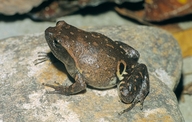|
Description
A medium-sized to large terrestrial microhylid, 45-65 mm, one female 62 mm. Colour in life, dark brown with small and larger whitish markings. Two large black spots, bordered with white, in the inguinal region. A light line forms a distinctive border between the back colouration and the uniformly dark coloured side of the head, and anterior part of the flanks. Venter whitish, with dark markings, which can become the dominant colouration. Skin on the back is smooth. Tympanum distinct, tympanum/eye ratio is about 3/4. Tibiotarsal articulation reaches the tympanum. Fingertips are not enlarged. Finger 2 as long as, or slightly shorter than, finger 4. Hands and feet are both without webbing (Glaw and Vences 1994).
Similar Species: The large inguinal spots are characteristic of this genus. Juveniles can be mistaken with P. bipunctata and P. notosticta (Glaw and Vences 1994). Distribution and Habitat
Country distribution from AmphibiaWeb's database: Madagascar
Found in Ampasimanolotra, Ampasinambo, Ankopakopaka forest, Ankovana, Antsihanaka, Mandriandry forest, Marojejy, Manombo, Marotreho forest, Nosy Mangabe, Sahembendrana (Glaw and Vences 2007) from sea level up to 900 m asl (Nussbaum et. al 2008).Life History, Abundance, Activity, and Special Behaviors
A dissected gravid female of 62 mm from Ampasinambo contained more than 100 eggs, 2 mm in diameter. A specimen from Nosy Mangabe emitted low, whistling release calls when touched (Glaw and Vences 1994).
Trends and Threats
Species is listed as least concern in view of its wide distribution, tolerance of a degree of habitat modification, presumed large population, and because it is unlikely to be declining fast enough to qualify for listing in a more threatened category (Nussbaum et. al 2008).
Though it occurs in many protected areas, its forest habitat is receding due to subsistence agriculture, timber extraction, charcoal manufacture, and invasive spread of eucalyptus, livestock grazing and expanding human settlements (Nussbaum et. al 2008). Possible reasons for amphibian decline General habitat alteration and loss
Habitat modification from deforestation, or logging related activities
Intensified agriculture or grazing
Urbanization
Comments
Taken with permission from Glaw and Vences (1994 and 2007) and Nussbaum et. al (2008).
References
Glaw, F. and Vences, M. (1994). Amphibians and Reptiles of Madagascar. M. Vences and F. Glaw Verlags GbR., Köln.
Glaw, F., and Vences, M. (2007). Field Guide to the Amphibians and Reptiles of Madagascar. Third Edition. Vences and Glaw Verlag, Köln.
Nussbaum, R., Andreone, F., and Vallan D. (2008). Plethodontohyla ocellata. In: IUCN 2008. 2008 IUCN Red List of Threatened Species. www.iucnredlist.org. Downloaded on 21 April 2009.
Originally submitted by: Miguel Vences and Frank Glaw (first posted 2001-10-23)
Edited by: Catherine Aguilar (2010-07-19)Species Account Citation: AmphibiaWeb 2010 Plethodontohyla ocellata <https://amphibiaweb.org/species/2355> University of California, Berkeley, CA, USA. Accessed Mar 30, 2025.
Feedback or comments about this page.
Citation: AmphibiaWeb. 2025. <https://amphibiaweb.org> University of California, Berkeley, CA, USA. Accessed 30 Mar 2025.
AmphibiaWeb's policy on data use.
|
